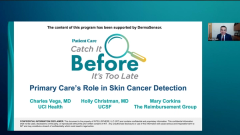
Barriers to Care: What Prevents Patients From Seeing a Dermatologist
Panelists discuss the anxieties primary care providers face in skin cancer evaluation—particularly the fear of missing a malignancy—while highlighting challenges such as limited diagnostic confidence, delayed dermatology access, and disparities in underserved areas, emphasizing the need for better tools and support to empower frontline clinicians and improve early detection.
Episodes in this series

This segment explored the anxieties that primary care providers face when evaluating patients for potential skin cancer, with the most prominent concern being the fear of missing a malignant lesion or delaying diagnosis. This shared anxiety was echoed across providers regardless of specialty, reinforcing the high stakes involved in early detection. The poll results reflected that even with some training, many still feel uncertain, particularly when skin exams are not a routine part of every visit. Limited confidence, rather than a lack of knowledge, often leads clinicians to take a more conservative approach, referring more frequently or hesitating when decisions aren't clear.
The discussion also addressed access to dermatology specialists. While some providers reported minimal delays, most indicated referral wait times of 1 to 2 months, with variability based on geography, patient resources, and clinic capacity. It was noted that in urgent cases, personal outreach to dermatologists can sometimes expedite appointments. However, systemic barriers—especially in rural and underserved urban communities—make timely access more difficult. These populations are already at greater risk due to higher sun exposure, fewer available specialists, and additional socioeconomic hurdles such as transportation or work flexibility.
The conversation underscored the disparity in outcomes for rural and underserved populations. These patients often present with more advanced cancers not only due to late detection but because systemic limitations mirror the effects seen during the COVID-19 lockdown, when delays in evaluation led to worse prognoses. This reinforces the vital need for primary care providers to have better tools, more support, and expanded capabilities. Ultimately, empowering frontline clinicians—especially in resource-limited areas—can bridge care gaps, reduce delays, and improve outcomes in skin cancer diagnosis and treatment.
Newsletter
Enhance your clinical practice with the Patient Care newsletter, offering the latest evidence-based guidelines, diagnostic insights, and treatment strategies for primary care physicians.













































































































































































































































































